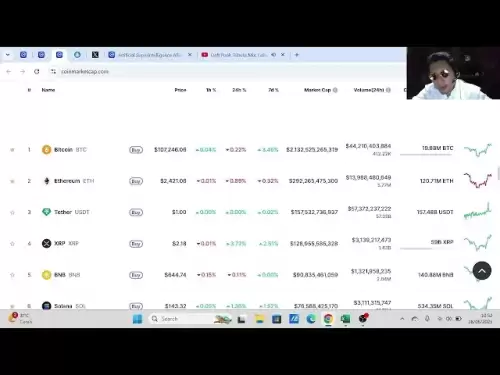-
 Bitcoin
Bitcoin $107,352.1067
0.28% -
 Ethereum
Ethereum $2,429.3531
-0.90% -
 Tether USDt
Tether USDt $1.0001
-0.02% -
 XRP
XRP $2.1894
4.62% -
 BNB
BNB $646.7968
0.36% -
 Solana
Solana $147.4290
4.03% -
 USDC
USDC $0.9998
-0.02% -
 TRON
TRON $0.2756
1.52% -
 Dogecoin
Dogecoin $0.1630
1.14% -
 Cardano
Cardano $0.5612
1.18% -
 Hyperliquid
Hyperliquid $37.0580
-0.05% -
 Bitcoin Cash
Bitcoin Cash $496.9410
-0.09% -
 Sui
Sui $2.7318
3.19% -
 Chainlink
Chainlink $13.1503
0.58% -
 UNUS SED LEO
UNUS SED LEO $9.0766
0.55% -
 Avalanche
Avalanche $17.7220
1.46% -
 Stellar
Stellar $0.2380
1.52% -
 Toncoin
Toncoin $2.8439
0.38% -
 Shiba Inu
Shiba Inu $0.0...01143
1.84% -
 Litecoin
Litecoin $85.8053
1.47% -
 Hedera
Hedera $0.1483
2.70% -
 Monero
Monero $314.3240
2.12% -
 Bitget Token
Bitget Token $4.6725
0.77% -
 Dai
Dai $1.0000
0.00% -
 Polkadot
Polkadot $3.3555
1.28% -
 Ethena USDe
Ethena USDe $1.0001
0.02% -
 Uniswap
Uniswap $7.0890
2.64% -
 Pi
Pi $0.5355
-3.40% -
 Pepe
Pepe $0.0...09393
1.06% -
 Aave
Aave $256.8136
-1.90%
How much money is needed to invest in virtual currency
To determine the appropriate investment amount for virtual currency, consider financial objectives, set a realistic budget based on disposable income, conduct thorough research and due diligence to assess risks and potential returns, diversify investments across different assets, start small to gain experience, and monitor regularly to adapt to market dynamics.
Jan 09, 2025 at 06:27 pm

Key Points:
- Determine Investment Objectives
- Set a Realistic Budget
- Research and Due Diligence
- Diversify Investments
- Start Small and Monitor Regularly
How Much to Invest in Virtual Currency
Investing in virtual currency can be a complex and potentially risky endeavor. The amount of money required to invest depends on several factors, including individual investment goals, financial situation, and risk tolerance. While there is no definitive answer, this guide will provide a comprehensive exploration of the considerations involved in determining the appropriate investment amount.
1. Determine Investment Objectives
The first step is to clearly define investment goals. Are you aiming for short-term gains, long-term growth, or diversification? Different objectives require different investment strategies and may influence the amount you need to invest.
Setting Investment Objectives:
- Short-term gains: Invest higher amounts to potentially capitalize on market fluctuations.
- Long-term growth: Invest smaller amounts consistently to build a portfolio over time.
- Diversification: Allocate a portion of an existing portfolio to virtual currency for diversification.
2. Set a Realistic Budget
Investing in virtual currency should not come at the expense of financial stability. Set a realistic budget that aligns with your income, expenses, and savings goals. Consider allocating a portion of disposable income, such as a percentage of monthly earnings.
Setting a Realistic Budget:
- Avoid investing more than you can afford to lose.
- Consider both potential gains and losses.
- Prioritize essential financial obligations over investments.
3. Research and Due Diligence
Once a budget is established, conduct thorough research on different virtual currencies. This includes understanding the underlying technology, market capitalization, team behind the project, and potential use cases. Avoid investing in projects that lack transparency or have questionable foundations.
Conducting Research and Due Diligence:
- Read whitepapers and visit project websites.
- Join virtual currency communities and forums.
- Seek advice from experienced investors or financial professionals.
4. Diversify Investments
Diversification is a crucial risk management strategy. Instead of concentrating investments in a single virtual currency, spread them across a portfolio of different assets. This helps mitigate volatility and potential losses in one project.
Diversifying Investments:
- Invest in a mix of established currencies like Bitcoin (BTC) and Ethereum (ETH), and emerging altcoins.
- Consider different sectors within the virtual currency space, such as DeFi, NFTs, and stablecoins.
5. Start Small and Monitor Regularly
Begin investing with a small amount that aligns with your comfort level. Avoid making large investments until you have gained experience and a better understanding of the market. Regularly monitor investments and adjust as needed based on market conditions and your objectives.
Starting Small and Monitoring Regularly:
- Start with a small investment that you can tolerate losing.
- Set up price alerts and regularly review market trends.
- Rebalance your portfolio as market dynamics change.
FAQs
What are the risks of investing in virtual currency?
- Volatility: Virtual currency prices can fluctuate significantly, leading to potential losses.
- Security risks: Exchanges and wallets can be hacked, resulting in lost funds.
- Regulatory uncertainty: The legal and regulatory landscape surrounding virtual currency is constantly evolving.
How do I choose a virtual currency to invest in?
- Consider factors such as market capitalization, team experience, technology, and potential use cases.
- Diversify investments across different virtual currencies to manage risk.
How much time should I spend on virtual currency investments?
- The time spent on investments depends on individual involvement and objectives.
- Stay informed about market trends and news, but avoid excessive trading.
- Long-term investors may need to spend less time on monitoring compared to short-term traders.
Is it too late to invest in virtual currency?
- The virtual currency market is constantly evolving, and it's never too late to invest.
- However, it's important to start with a realistic understanding of risks and potential returns.
Disclaimer:info@kdj.com
The information provided is not trading advice. kdj.com does not assume any responsibility for any investments made based on the information provided in this article. Cryptocurrencies are highly volatile and it is highly recommended that you invest with caution after thorough research!
If you believe that the content used on this website infringes your copyright, please contact us immediately (info@kdj.com) and we will delete it promptly.
- SEI Mirroring Solana: Price Spikes and the Next Big Crypto?
- 2025-06-28 20:52:13
- PENGU Price Surges: Are Whales Targeting $0.0149?
- 2025-06-28 20:30:12
- Notcoin's Wild Ride: Price Swings, Market Cap, and What's Next
- 2025-06-28 20:30:12
- COMP Price Wobbles as a16z Moves Tokens Amid Crypto Jitters
- 2025-06-28 20:52:13
- Bitcoin, XRP, and Macro Trends: Navigating the Crypto Landscape in 2025 and Beyond
- 2025-06-28 20:55:12
- Navigating Offshore Casinos: A Safe Haven for US Players?
- 2025-06-28 20:55:12
Related knowledge
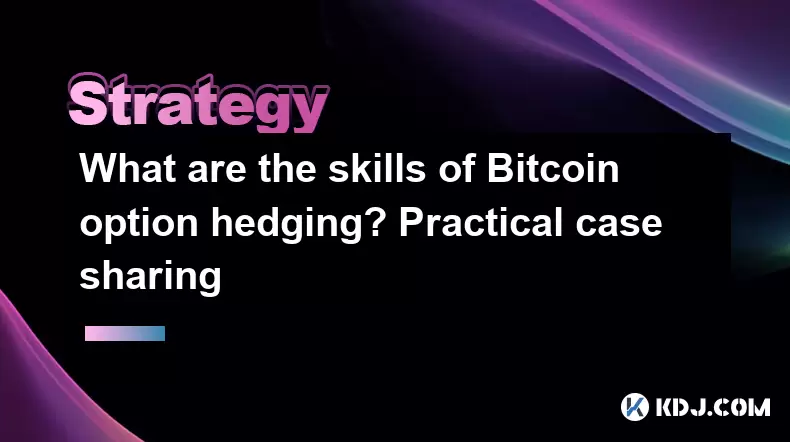
What are the skills of Bitcoin option hedging? Practical case sharing
Jun 24,2025 at 04:01pm
Understanding Bitcoin Option HedgingBitcoin option hedging is a risk management strategy used by traders and investors to protect their positions in the volatile cryptocurrency market. By using options, individuals can limit potential losses while retaining the opportunity for profit. In essence, it allows one to insulate against adverse price movements...
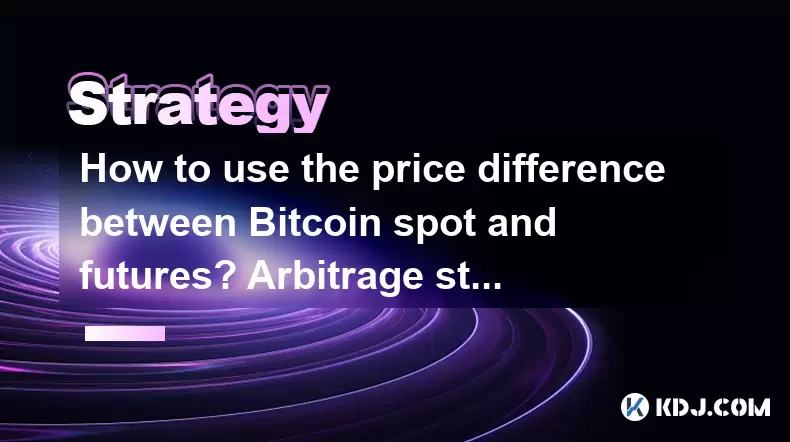
How to use the price difference between Bitcoin spot and futures? Arbitrage strategy
Jun 20,2025 at 02:56pm
Understanding Bitcoin Spot and Futures MarketsTo effectively leverage arbitrage opportunities between Bitcoin spot and futures markets, it's essential to understand the fundamental differences between these two types of markets. The spot market refers to the direct buying and selling of Bitcoin for immediate delivery at the current market price. In cont...
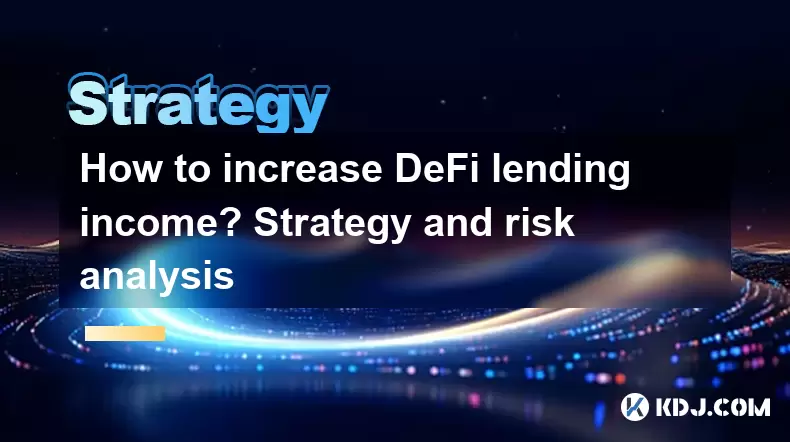
How to increase DeFi lending income? Strategy and risk analysis
Jun 24,2025 at 02:08pm
Understanding DeFi Lending and Its Income PotentialDeFi (Decentralized Finance) lending has emerged as a popular way to earn passive income in the cryptocurrency space. Unlike traditional banking systems, DeFi lending platforms allow users to lend their crypto assets directly to borrowers without intermediaries. The lenders earn interest based on the su...
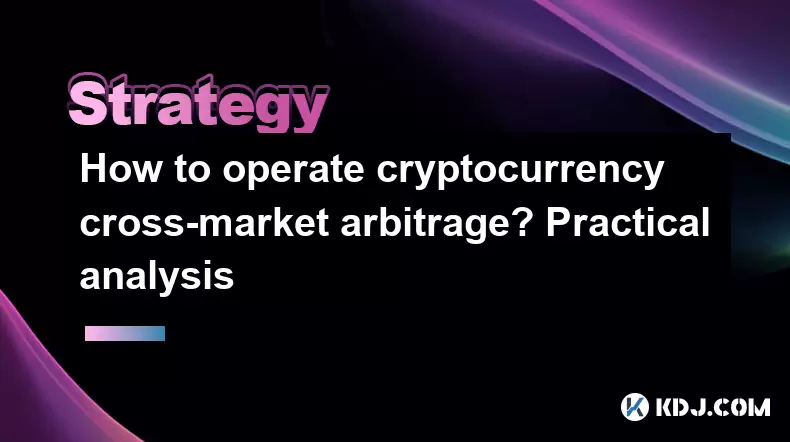
How to operate cryptocurrency cross-market arbitrage? Practical analysis
Jun 23,2025 at 04:01am
Understanding Cryptocurrency Cross-Market ArbitrageCryptocurrency cross-market arbitrage involves taking advantage of price differences for the same digital asset across different exchanges. The core idea is to buy low on one exchange and sell high on another, capturing the profit from the discrepancy. This strategy relies heavily on real-time market da...

How to make profits from high-frequency cryptocurrency trading? Sharing core skills
Jun 19,2025 at 05:07pm
Understanding High-Frequency Cryptocurrency TradingHigh-frequency trading (HFT) in the cryptocurrency market involves executing a large number of trades at extremely fast speeds, often within milliseconds. This method relies on small price discrepancies across exchanges or within a single exchange’s order book. Traders use complex algorithms and ultra-l...
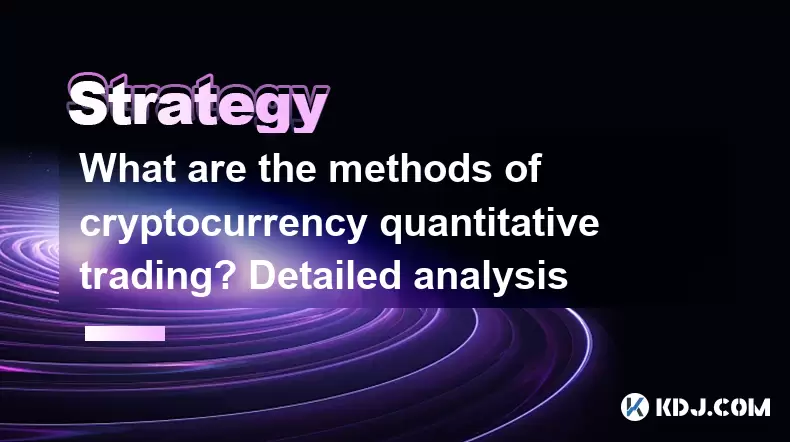
What are the methods of cryptocurrency quantitative trading? Detailed analysis
Jun 22,2025 at 11:07pm
Understanding the Core of Cryptocurrency Quantitative TradingCryptocurrency quantitative trading refers to the use of mathematical models and algorithms to execute trades in the digital asset market. Unlike traditional discretionary trading, which relies heavily on human judgment, quantitative trading leverages data-driven strategies to identify profita...

What are the skills of Bitcoin option hedging? Practical case sharing
Jun 24,2025 at 04:01pm
Understanding Bitcoin Option HedgingBitcoin option hedging is a risk management strategy used by traders and investors to protect their positions in the volatile cryptocurrency market. By using options, individuals can limit potential losses while retaining the opportunity for profit. In essence, it allows one to insulate against adverse price movements...

How to use the price difference between Bitcoin spot and futures? Arbitrage strategy
Jun 20,2025 at 02:56pm
Understanding Bitcoin Spot and Futures MarketsTo effectively leverage arbitrage opportunities between Bitcoin spot and futures markets, it's essential to understand the fundamental differences between these two types of markets. The spot market refers to the direct buying and selling of Bitcoin for immediate delivery at the current market price. In cont...

How to increase DeFi lending income? Strategy and risk analysis
Jun 24,2025 at 02:08pm
Understanding DeFi Lending and Its Income PotentialDeFi (Decentralized Finance) lending has emerged as a popular way to earn passive income in the cryptocurrency space. Unlike traditional banking systems, DeFi lending platforms allow users to lend their crypto assets directly to borrowers without intermediaries. The lenders earn interest based on the su...

How to operate cryptocurrency cross-market arbitrage? Practical analysis
Jun 23,2025 at 04:01am
Understanding Cryptocurrency Cross-Market ArbitrageCryptocurrency cross-market arbitrage involves taking advantage of price differences for the same digital asset across different exchanges. The core idea is to buy low on one exchange and sell high on another, capturing the profit from the discrepancy. This strategy relies heavily on real-time market da...

How to make profits from high-frequency cryptocurrency trading? Sharing core skills
Jun 19,2025 at 05:07pm
Understanding High-Frequency Cryptocurrency TradingHigh-frequency trading (HFT) in the cryptocurrency market involves executing a large number of trades at extremely fast speeds, often within milliseconds. This method relies on small price discrepancies across exchanges or within a single exchange’s order book. Traders use complex algorithms and ultra-l...

What are the methods of cryptocurrency quantitative trading? Detailed analysis
Jun 22,2025 at 11:07pm
Understanding the Core of Cryptocurrency Quantitative TradingCryptocurrency quantitative trading refers to the use of mathematical models and algorithms to execute trades in the digital asset market. Unlike traditional discretionary trading, which relies heavily on human judgment, quantitative trading leverages data-driven strategies to identify profita...
See all articles























